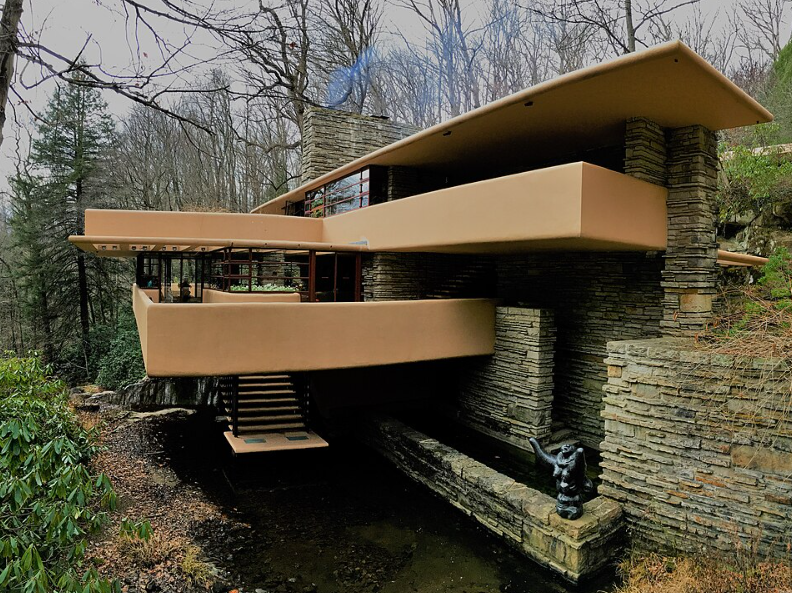🌳 Ep. 206: Frank Lloyd Wright – Top 6 Buildings Memory Mnemonic
👋 Intro
Hello and welcome to this episode of the podcast, "The Mnemonic Memory", where we add a single mnemonic leaf to our Tree of Knowledge.
I’m Jans, your Mnemonic Man, and today's episode is on a man who was recognised as the greatest American architect of all time by the American Institute of Architects, Frank Lloyd Wright.
Born in Wisconsin in 1867, Frank Lloyd Wright was destined for greatness, well, at least according to his mum, who encouraged and supported his interest in design. With a career of over 70 years, Wright designed more than a thousand structures, with about 500 built. These structures ranged from private homes to museums, churches, and office buildings.
Known mainly for his spiral masterpiece in New York City, the Guggenheim Museum, his other most famous work is Fallingwater, which is a Pennsylvania home, dramatically cantilevered over a waterfall, his finest example of “organic architecture.
Another style he is famous for is the Prairie style, which emphasized horizontal lines, open floor plans, and harmony with the surrounding landscape.
Wright had a tumultuous personal life, with three marriages, many children, scandals, financial troubles, and a horrific tragedy that involved a fire and the murder of seven people.
Along with his architectural work, Wright also wrote books, articles, and lectured, all of which culminated in influencing generations of architects worldwide.
Today’s mnemonic will be on Frank Lloyd Wright’s top 6 buildings.
So, with that being said, we will begin with a summary from Wikipedia.
📖 Wikipedia Summary
Frank Lloyd Wright Sr. (June 8, 1867 – April 9, 1959) was an American architect, designer, writer, and educator. He designed more than 1,000 structures over a creative period of 70 years. Wright played a key role in the architectural movements of the twentieth century, influencing architects worldwide through his works and mentoring hundreds of apprentices in his Taliesin Fellowship.[1][2]
Wright believed in designing in harmony with humanity and the environment, a philosophy he called organic architecture. This philosophy was exemplified in Fallingwater (1935), which has been called "the best all-time work of American architecture".[3]
Wright was a pioneer of what came to be called the Prairie School movement of architecture and also developed the concept of the Usonian home within Broadacre City, his vision for urban planning in the United States.
Wright also designed original and innovative offices, churches, schools, skyscrapers, hotels, museums, and other commercial projects. Wright-designed interior elements (including leaded glass windows, floors, furniture and even tableware) were integrated into these structures. He wrote several books and numerous articles and was a popular lecturer in the United States and in Europe.
Wright was recognized in 1991 by the American Institute of Architects as "the greatest American architect of all time".[3] In 2019, a selection of his work became a listed World Heritage Site under the name The 20th-Century Architecture of Frank Lloyd Wright.
Raised in rural Wisconsin, Wright studied civil engineering at the University of Wisconsin and later apprenticed in Chicago, first briefly with Joseph Lyman Silsbee, and then with Louis Sullivan at Adler & Sullivan. Wright opened his own successful Chicago practice in 1893 and established a studio in his Oak Park, Illinois home in 1898.
His fame increased, and his personal life sometimes made headlines: leaving his first wife Catherine "Kitty" Tobin for Mamah Cheney in 1909; the murder of Mamah, her children, and others at his Taliesin estate by a staff member in 1914; his tempestuous marriage with second wife Miriam Noel (m. 1923–1927); and his courtship and marriage to Olgivanna Lazović (m. 1928–1959).
Extracted from: [https://en.wikipedia.org/wiki/Frank_Lloyd_Wright]
🧠 Memory Mnemonic
Frank Lloyd Wright – Top 6 Buildings Memory Mnemonic – Guggenheim TTURF
(Picture Frank Lloyd Wright coming back to life and laying turf all around the Guggenheim Museum to soften the giant concrete structure and blend it in more with the environment)
1. Guggenheim Museum
2. Taliesin
3. Taliesin West
4. Unity Temple
5. Robie House
6. Fallingwater
🔎 Five Fun Facts
1. Frank Lloyd Wright’s mother believed he was destined to become a great architect from a very young age. She decorated his nursery with pictures of famous cathedrals and even gave him wooden building blocks to inspire his creativity. This early influence seemed to work and shaped his lifelong passion for design.
2. Frank Lloyd Wright had a colourful, dramatic, and tragic personal life. He abandoned his spouse, children, and practice in 1909 to run away with a client, Mamah Borthwick Cheney whom he was building a house for. In 1914 a disgruntled servant set fire to Lloyd’s Taliesin home before murdering seven of the home’s residents, including Wright’s then-partner, Mamah Borthwick Cheney. He was also arrested for violating the Mann Act, which was a federal law that prohibited the transportation of women across state lines for immoral purposes, a charge which was later dropped.
3. One of Wright’s most famous works was, Fallingwater, which was designed to sit directly over a waterfall in Pennsylvania. Instead of placing it beside the waterfall as was expected, Wright surprised his clients by integrating the home into the landscape. This became one of the most celebrated examples of organic architecture.
4. The Solomon R. Guggenheim Museum in New York is one of Wright’s most iconic buildings. Its spiral ramp which looks like a seashell, allows visitors to view art in a continuous flow rather than moving from room to room. This masterpiece took Wright 16 years to complete and is on Fifth Avenue in New York.
5. During his career, Wright created designs for over 1,000 structures, with approximately 500 that were actually constructed. His works included homes, offices, hotels, skyscrapers, churches, schools, museums, and even a gas station. This prolific output made him one of the most influential architects of the 20th century, and if you listen to Frank Lloyd Wright himself, who not so humbly declared, he was “the world’s greatest architect.”
🎓 Three-Question Quiz
Q.1. Which state was Frank Lloyd Wright born in?
Q.2. Wright developed an architectural philosophy that emphasized harmony between human habitation and the natural world. What did he call it?
Q.3. Which Midwestern city has the largest number of Wright-designed buildings?
Bonus Q. What is the name of the style of houses Wright created in the early 1900s that featured horizontal lines and open interior spaces? Hint: a type of grassland
Bonus Q. Why did the architect get fired for his library design?
A. Because it only had one Story!
🧠 Memory Mnemonic Recap
Frank Lloyd Wright – Top 6 Buildings Memory Mnemonic – Guggenheim TTURF
(Picture Frank Lloyd Wright coming back to life and laying turf all around the Guggenheim Museum to soften the giant concrete structure and blend it in more with the environment)
1. Guggenheim Museum
2. Taliesin
3. Taliesin West
4. Unity Temple
5. Robie House
6. Fallingwater
🎓 Three-Question Quiz Answers
Q.1. Which state was Frank Lloyd Wright born in?
A. Wisconsin
Q.2. Wright developed an architectural philosophy that emphasized harmony between human habitation and the natural world. What did he call it?
A. Organic Architecture
Q.3. Which Midwestern city has the largest number of Wright-designed buildings?
A. Chicago
Bonus Q. What is the name of the style of houses Wright created in the early 1900s that featured horizontal lines and open interior spaces? Hint: a type of grassland
A. Prairie style
Bonus Q. Why did the architect get fired for his library design?
A. Because it only had one Story!
🔤 Word of the Week
myriad
[ mir-ee-uhd ] adjective
too many to count
Example
Frank Lloyd Wright’s architectural legacy is defined by a myriad of innovative designs, from the natural harmony of Fallingwater to the geometric brilliance of the Guggenheim Museum.
Extracted from: [https://www.dictionary.com/]
💡 Memory Tip
Our memory tip today is the mnemonic, Rhymes & Songs which use rhythm, rhyme, and melody to make information easier to recall.
By setting information you would like to remember to a familiar tune or catchy rhyme, the brain links memory with music, which improves retention and recall. Two great examples for this would be “i before e, except after c” and the alphabet song.
As music engages multiple parts of the brain, this strengthens the memory pathways and thus helps with long-term memory. Check out episode 130 for a great rhyming mnemonic to remember, the original band members of “The Beach Boys” which is ABCD Melody.
1. Al Jardine
2. Brian Wilson
3. Carl Wilson
4. Dennis Wilson
5. Mike Love
See you next week.
👉 Free Memory Mnemonics at:
https://www.themnemonictreepodcast.com
🎧 Listen on Apple Podcasts:
https://podcasts.apple.com/au/podcast/the-mnemonic-tree-podcast/id1591795132
🎧 Listen on Spotify:
https://open.spotify.com/show/3T0LdIJ9PBQMXM3cdKd42Q?si=fqmaN2TNS8qqc7jOEVa-Cw
🔗 References
https://chatgpt.com/c/68c0c524-0dcc-8320-bea5-9aea337999e7
https://kids.kiddle.co/Frank_Lloyd_Wright
https://www.architecturaldigest.com/story/frank-lloyd-wright-facts
https://upjoke.com/architect-jokes
https://www.archdaily.com/873273/26-things-you-didnt-know-about-frank-lloyd-wright
https://crystalbridges.org/blog/little-know-facts-about-frank-lloyd-wright/



